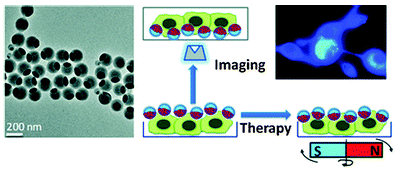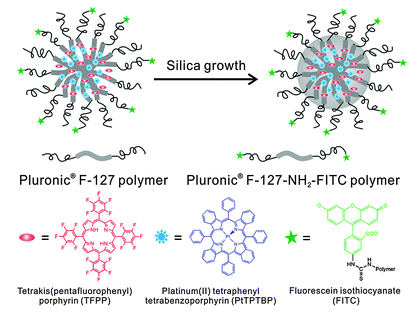24.Design, synthesis and bioimaging applications of aromatic-ring AIE fluorescent nanoparticles based on β -cyclodextrin
AIE 型荧光纳米粒子是一种利用聚集诱导发光(AIE)现象的纳米材料,具有高荧光量子产率、高稳定性、低背景信号等优点,可以用于生物成像、传感、显示等领域。
β-环糊精是一种具有内腔疏水、外腔亲水的大环超分子主体,可以通过包合作用与多种分子形成超分子复合物,改善其溶解性、稳定性、选择性等性质。
通过在 β-环糊精上引入无芳香环的 AIE 分子,可以构建出具有高亮度、高选择性、高生物相容性的 AIE 型荧光纳米粒子,用于检测和成像生物体内的不同靶标。
利用基于 β-环糊精的无芳香环 AIE 型荧光纳米粒子实现对动脉粥样硬化(AS)的早期检测和药物筛选。利用一种含有罗丹明结构单元的无芳香环 AIE 分子(Rho-AIE)与 β-环糊精通过包合作用形成超分子纳米粒子(Rho-AIE@CD),并通过静电吸附将其负载在阳离子型聚乙二醇(cPEG)上,制备出具有高亮度和高稳定性的荧光探针(Rho-AIE@CD-cPEG)。该荧光探针可以特异性地识别和标记 AS 患者血清中的氧化低密度脂蛋白(ox-LDL),并在近红外区域发出强烈的荧光信号,实现对 AS 的早期诊断。同时,该荧光探针还可以与 AS 治疗药物西地那非(SDF)形成超分子复合物(Rho-AIE@CD-cPEG-SDF),并通过靶向输送到 AS 斑块处,释放出 SDF 药物,抑制 AS 的进展。该技术为 AS 的早期检测和治疗提供了一种新型的 AIE 型荧光纳米平台。
AIE type fluorescent nanoparticles are a kind of nanomaterials using aggregation-induced luminescence (AIE) phenomenon. With the advantages of high fluorescence quantum yield, high stability and low background signal, they can be used in biological imaging, sensing, display and other fields. β -Cyclodextrin is a large cyclic supramolecular body with hydrophobic and hydrophilic in the inner cavity. It can form supramolecular complexes with various molecules through package cooperation and improve its solubility, stability, selectivity and other properties. By introducing AIE molecules on β -cyclodextrins, AIE type fluorescent nanoparticles with high brightness, high selectivity and high biocompatibility can be constructed for the detection and imaging of different targets in the organism. Early detection and drug screening of atherosclerosis (AS) is achieved using aromatic-ring AIE fluorescent nanoparticles based on β -cyclodextrin. Using a non-aromatic ring AIE molecule (Rho-AIE) and β -cyodextrin formed ultra-molecular nanoparticles (Rho-AIE @ CD) and loaded on cationic polyethylene glycol (cPEG) by electrostatic adsorption to produce a fluorescent probe (Rho-AIE @ CD-cPEG). This fluorescent probe can specifically identify and label the oxidized low-density lipoprotein (ox-LDL) in the serum of AS patients, and emit a strong fluorescent signal in the near-infrared region, realizing the early diagnosis of AS. At the same time, the fluorescent probe can also form a supramolecular complex (Rho-AIE @ CD-cPEG-SDF) with the AS therapeutic sildenafil (SDF), which is targeted delivered to release SDF drugs to inhibit the progression of AS. This technique provides a novel AIE type fluorescent nanoplatform for the early detection and treatment of AS.


Reference Documentation:
[1]Mei J, Leung N L C, Kwok R T K, et al. Aggregation-induced emission: together we shine, united we soar![J]. Chemical reviews, 2015, 115(21): 11718-11940. https://pubs.acs.org/doi/10.1021/acs.chemrev.5b00263
[2]García R, Martín C, de la Fuente J M. Cyclodextrin-based nanomaterials for therapeutic and diagnostic applications[J]. Chemical Society Reviews, 2018, 47(15): 5615-5635. https://pubs.rsc.org/en/content/articlelanding/2018/cs/c8cs00176a
[3]Wang K, Ding D, Tang B Z. Highly Bright AIE Nanoparticles by Regulating the Substituent of Rhodanine for Precise Early Detection of Atherosclerosis and Drug Screening[J]. Advanced Materials, 2021, 33(4): 2005988. https://onlinelibrary.wiley.com/doi/10.1002/adma.202005988
+86-18915413828(WhatsApp&WeChat)
Previous: Intracellular in situ
Next: BK Oncolytic virus pla


